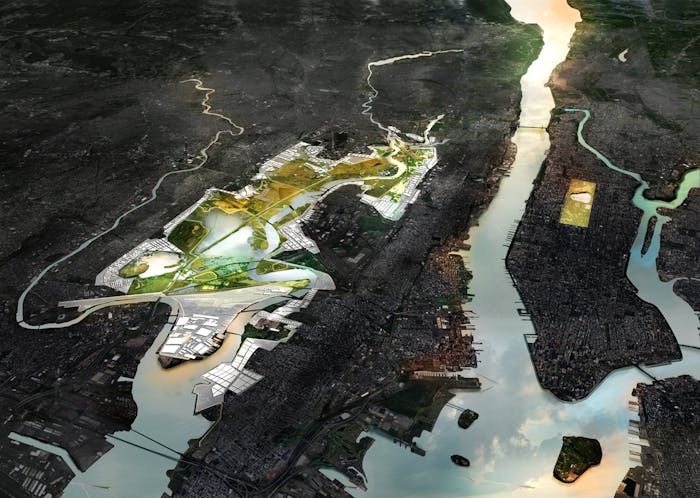The Team
Team Leads: MIT Center for Advanced Urbanism (CAU), Zones Urbaines Sensibles (ZUS), and DE URBANISTEN Eco-Engineering: Deltares Infrastructure Engineering: Volker Infradesign Graphic and Communication Design: 75B
Source: Rebuild by Design

Team Leads: MIT Center for Advanced Urbanism (CAU), Zones Urbaines Sensibles (ZUS), and DE URBANISTEN Eco-Engineering: Deltares Infrastructure Engineering: Volker Infradesign Graphic and Communication Design: 75B
Source: Rebuild by Design
The low-lying Meadowlands, a flood-prone area located across the Hudson River from New York City, is home to critical power, wastewater treatment, and transportation infrastructure for the region.
These facilities include two airports and thousands of acres of rail yards, as well as 14 separate municipalities and 150,000 jobs. Interventions here need to address the combined effects of flooding, heat islands, pollution, social vulnerability, and vital network protection.
Almost 10 miles from the coast, parts of the Meadowlands were inundated by Hurricane Sandy. Flooding affected both warehouses and residences. Because the municipal sewer system cannot handle rainwater runoff, the area regularly floods during strong rainstorms.
Project Details: Location: The Meadowlands: Little Ferry, Teterboro, Moonachie, South Hackensack, Carlstadt, NJ Award: $150 Million Implemented By: State of New Jersey, Department of Community Affairs; to be administered by the Department of Environmental Protection
Source: Rebuild by Design
The New Meadowlands proposal comprises three flood risk reduction projects: Protect, Connect, and Grow.
Protect: A “Meadowpark,” will transform the Meadowlands into a flood-protected regional public park by connecting and expanding past marshland restoration with a system of berms and marshes
Connect: A “Meadowband” offers flood protection, connections between towns and wetlands, and access points to “Meadowpark.” It imagines new bike lanes that would connect to New York City and a Bus Rapid Transit system that would link the communities to one another and to the regional rail line.
Grow: The Grow project proposes development opportunities such as new, mixed-use housing, enhancements to public transportation, new energy sources and distribution systems, and creating a series of public spaces and recreation zones.
The New Meadowlands proposal focuses on flood risk reduction projects in Bergen County in the towns of Little Ferry and Moonachie, which experienced the most damage during Sandy and encompasses a total of five municipalities.
View the team's full proposal here Source: Rebuild by Design
The State of New Jersey is evaluating the feasibility of options for the project.
These include systems of berms that could improve streetscapes, active recreation in a resilient park, and transportation infrastructure, while reducing flood risks from the Hackensack River and protecting against flooding in western and southern parts of the Meadowlands. The ongoing community engagement process for the project will allow the State to work with affected communities to design alternatives.
Source: Rebuild by Design